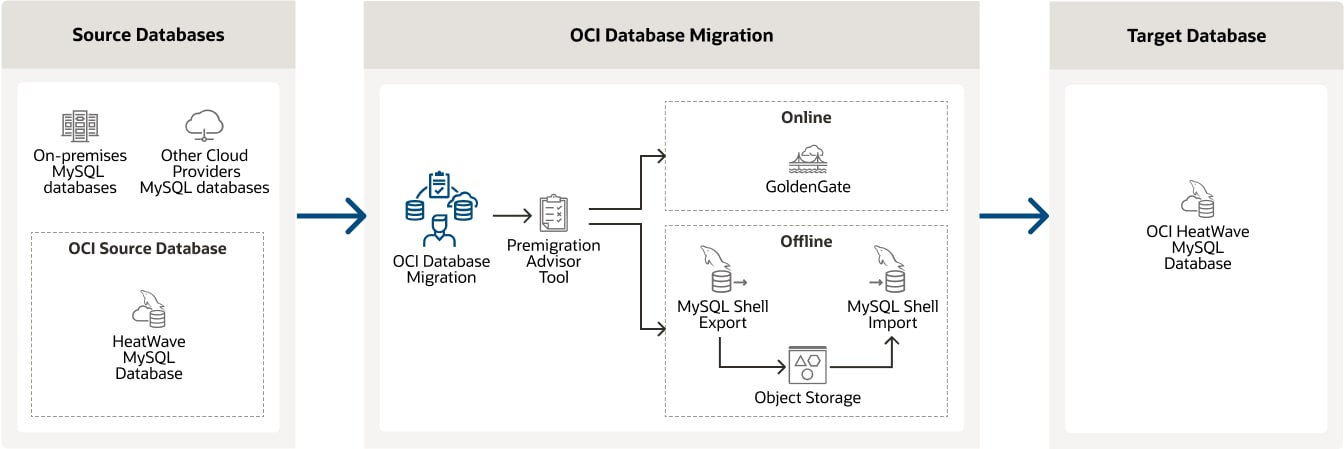OCI Database Migration for MySQL Databases
OCI Database Migration migrates MySQL databases from on-premises or cloud deployments to OCI. The easy-to-use graphical user experience validates and manages online or offline migration workflows. Migration for MySQL databases transparently uses the MySQL Shell, a migration advisor, and GoldenGate.
Migration service features:
How migration works
 Supported source databases can be on-premises, OCI, or in other cloud providers. Using the OCI Database migration service, users create source and target database connections and select between online or offline migration. In the validation phase, a migration advisor assesses source and target compatibility, looks for potentially problematic content, and makes recommendations. After all errors are resolved, data is exported through the MySQL Shell into Object Store and imported into the target database. In the online case, after the initial load, ongoing replication uses GoldenGate.
Supported source databases can be on-premises, OCI, or in other cloud providers. Using the OCI Database migration service, users create source and target database connections and select between online or offline migration. In the validation phase, a migration advisor assesses source and target compatibility, looks for potentially problematic content, and makes recommendations. After all errors are resolved, data is exported through the MySQL Shell into Object Store and imported into the target database. In the online case, after the initial load, ongoing replication uses GoldenGate. Sources and target
OCI Database Migration for MySQL supports the following MySQL variants, versions, and deployment sources. The flexibility of a logical migration allows for version upgrades and changes to target platforms.
 OCI Database Migration for MySQL supports the following MySQL source database versions: 5.7 through 8.0. These deployments can be on-premises, on OCI or OCI Classic, Amazon RDS, Google Cloud, Microsoft Azure. There are many MySQL variants and Oracle supports: AWS RDS MySQL, AWS Aurora, , GCP MySQL, and Azure MySQL, The Target platform is Heatwave MySQL on Oracle Cloud Infrastructure.
OCI Database Migration for MySQL supports the following MySQL source database versions: 5.7 through 8.0. These deployments can be on-premises, on OCI or OCI Classic, Amazon RDS, Google Cloud, Microsoft Azure. There are many MySQL variants and Oracle supports: AWS RDS MySQL, AWS Aurora, , GCP MySQL, and Azure MySQL, The Target platform is Heatwave MySQL on Oracle Cloud Infrastructure. Migration workflows
Migration workflows meet both simple and complex operational requirements without the need for advanced DBA skills. Migrations can run whether applications are online or offline. For online migrations, an initial load is followed by applying ongoing incremental changes. Logical workflows can also include version upgrades.
| HeatWave MySQL Database | |
|---|---|
| Logical offline migration | yes |
| Logical online migration | yes |
Business continuity
Offline migration
- Applications are offline during migration
- Duplicates entire database in one operation
Online migration
- Applications are online during migration
- Captures incremental source database changes in real-time and continuously applies them to target database
Data movement
Logical migration
- Captures source data and metadata separate from physical data using MySQL Shell and ongoing changes with GoldenGate
- Enables source and target databases to be different versions and platforms
Network connection
Direct connection
- Source and target are on the same physical or virtual network
Embedded migration advisor
A diagnostic advisor is embedded into the migration workflow. The advisor prioritizes exceptions, suggests resolutions, and generates repair scripts. Users can interactively review the details and either ignore the warnings, exclude source objects, or make repairs. The convenience of this essential step streamlines the migration workflow.
 The migration advisor process has four steps. 1: Identify exceptions in the form of "Action Required," "Review Required," and "Review Suggested." 2: Present findings, including exception detail and repair advice, and provide repair scripts. 3: Users take actions on the findings, including accept, run repair scripts, reject, or exclude. 4: After actions are taken, users rerun the advisor. Additional buttons allow you read or watch a demonstration of this process.
The migration advisor process has four steps. 1: Identify exceptions in the form of "Action Required," "Review Required," and "Review Suggested." 2: Present findings, including exception detail and repair advice, and provide repair scripts. 3: Users take actions on the findings, including accept, run repair scripts, reject, or exclude. 4: After actions are taken, users rerun the advisor. Additional buttons allow you read or watch a demonstration of this process.